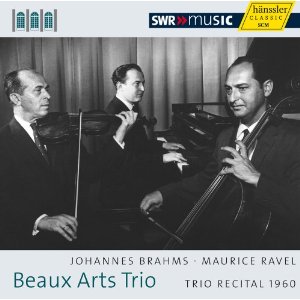BEAUX ARTS TRIO CD with Brahms and Ravel.
BEAUX ARTS TRIO
Trio Recital 1960
Beaux Arts Trio: – Daniel Guilet, violin, – Bernard Greenhouse, cello, – Menahem Pressler, piano
JOHANNES BRAHMS : Trio for violin, cello and piano n. 1, op. 8
MAURICE RAVEL: Trio for violin, cello and piano
Review by Fabio Bardelli
This historic CD, consisting of two masterpieces from the chamber music repertoire, was recorded by the Beaux Arts Trio in 1960 at a Liederabend given in Schwetzingen. Between the years 1955 to 2008, despite some changes, the Beaux Arts Trio was regarded as one of the great piano trios. The Trio was active in the recording studio and in concert halls around the world. They made many recordings across an extremely wide repertoire
. The artistic life of the Beaux Arts Trio is certainly one of the longest ever.
In this CD we find the Trio still comprising its original musicians; over the next few years there were changes, violinists and cellists, but this did not affect their standard of performance. The pianist Menahem Pressler, one of the founder members, has always been at the centre of the Trio and the instigater of musical ideas. Sometimes we have the impression that just one person is playing, so close are their shared ideas about how to play together
investigated. The appropriate evaluation of all men with sildenafil citrate • “When did your erection problems begin?” “Please.
.
Maurice Ravel’s Piano Trio is one of the most famous in the whole repertoire. Written at the time of the First World War it has the characteristic Ravel features. Moreover it bases some of its ideas on popular tunes, transforming them into a dream like atmosphere full of bewitching sounds. The fast movements make a striking impression even at first hearing, while repeated listening reveals the extraordinary exquisite writing of the Passacaglia.
The Beaux Arts Trio looks back to the 19th Century and considers Ravel as one of the late Post-Romantic composers. The extremely refined sound and the timbre of the music creates an atmosphere reminiscent of post-Brahms music rather than looking forward to the music of the 20th Century. The tempos, rather moderate, allow this chamber ensemble to play with absolute mastery every phrase and to balance perfectly their parts of Ravel’s great masterpiece. Perhaps in the faster tempos some emotional tension is missing, but the main purpose of the Beaux Arts Trio is always referring back to a classical background.
Maybe the performance of Johannes Brahms’s Trio Nr 1 op. 8 for violin, cello and piano is more stylish. It is an early piece which Brahms later modified, although here we have the original version. The pianist Menahem Pressler is a master at communicating his ideas to his colleagues, but we must also notice the great expressive style of Bernard Greenhouse, especially in the Allegro con brio movement, and the stylish playing of Daniel Guilet in the third movement Adagio with its flair and introspection. A really thrilling interpretation of this Brahms Trio.
The sound, the packaging and the presentation, with ample notes, are excellent.
Fabio Bardelli
translation from italian Riccardo Rosetti
BEAUX ARTS TRIO
Trio Recital 1960
JOHANNES BRAHMS
Trio for violin, cello and piano n. 1, op. 8
MAURICE RAVEL
Trio for violin, cello and piano
Beaux Arts Trio: – Daniel Guilet, violin, – Bernard Greenhouse, cello, – Menahem Pressler, piano
1 CD
Hässler 93.715

